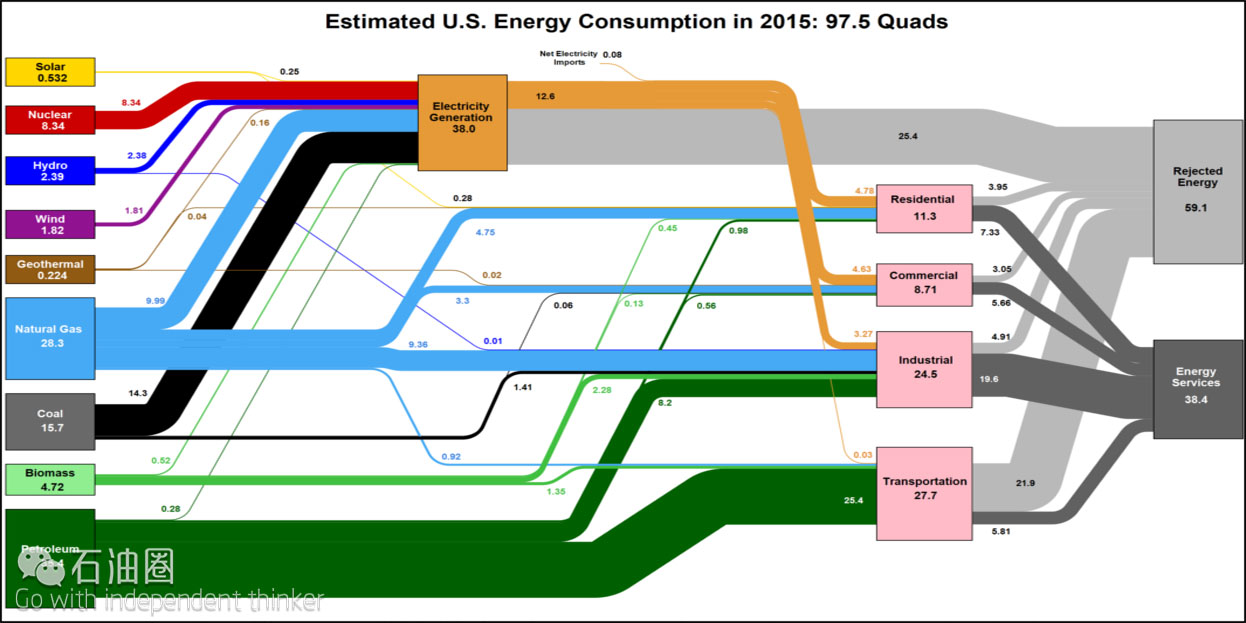
上面的图表是一种特殊的流程图,称为桑基图。此图展示了2015年美国能源消耗总量,并且呈现了各个能源的来源及其去向。
美国97.5 quads的能源消耗意味着什么?
由图可知,2015年美国能源消耗总量约为97.5 quads。quads是相当于千万亿英热的衡量单位,它所创造的能量相当于:
80.7亿加仑汽油
2930.71亿千瓦时
3600万吨煤炭
9704.34亿立方英尺天然气
2520万吨石油
2.52亿吨TNT
13.3吨铀-235
97.5 quads是如此大的能源消耗量,但是如果大家仔细看图的话,你会发现其中59.1 quads能源消耗实际上是被浪费掉的。比如汽车,汽油燃烧产生的能量大部分转化为热能而不是机械能。内燃机的平均燃料利用率仅有20%,而如果利用率能够提升至40%,人们就会感到兴奋无比。
天然气引擎效率更是异常的低,其他能源的利用率也大都如此。如果仔细观察表中的电力生产部分,我们会发现用于生产电力的67%的能源都是浪费的。
在绿色能源方面,太阳能消耗仅占0.53 quads,风能占1.82 quads。绿色能源、电池以及储能方面仍有许多障碍需要克服,绿色能源还有很大发展空间。
中国石油进口量&能源利用率
反观中国,中国对进口石油的依赖程度达到了56%以上,中国成为世界第一能源消费大国早已是不争的事实。客观来讲,这一境况与这些年来中国经济保持强势增长、汽车销售大幅提高以及人民生活水平显著改善等不无关系。
但这也不是主要原因,因为中国经济总量与美国相比还相差甚远,如果能源利用效率相同,在石油进口量方面是不可能超过美国的。中国之所以成为世界第一能源消耗大国,且石油进口超过美国,就在于中国的能源利用效率过低,能源浪费现象过于严重。
据有关方面提供的数据,中国能源消耗是美国的3倍。也就是说,生产同样的产品,中国比美国多消耗的能源要高。想一想,如果能源利用率能够提高到发达国家一半的水平,中国的能源消耗将减少多少?还可能在这么短的时间内就成为世界第一的能源消耗大国和石油进口大国吗?能源浪费现象本隶属于物理定律,但是目前,仍有许多方面需要做出改善,来提高能源利用率。
能源进口量与能源利用率息息相关,对于这一话题,欢迎大家分享各见自解,在下方留言,共同探讨。
作者/JEFF DESJARDINS 编译/徐文凤
Today’s graphic is special type of flow chart, called a Sankey diagram.
This particular one shows the total estimated energy consumption in the United States in 2015, and how energy flowed from source to the final destination. The graphic comes to us from the Lawrence Livermore National Laboratory and the Department of Energy.
The beauty of a Sankey is in its simplicity and and effectiveness. No information is left out, and we can really see the full energy picture from a 10,000 foot view.
WASTED EFFORT
The U.S. is estimated to have consumed 97.5 quads of energy in 2015.
What’s a quad? It’s equal to a quadrillion BTUs, which is roughly comparable to any of these:
8,007,000,000 gallons (US) of gasoline
293,071,000,000 kilowatt-hours (kWh)
36,000,000 tonnes of coal
970,434,000,000 cubic feet of natural gas
25,200,000 tonnes of oil
252,000,000 tonnes of TNT
13.3 tonnes of uranium-235
It’s a lot of energy – and if you look at the diagram, you’ll see most of it is actually wasted.
It’s estimated that 59.1 quads (60.6% of all energy) is “rejected energy”, a fancy term for energy that is produced but not used in an effective way. For example, when gasoline is burned in a car, most of the energy comes off as heat instead of doing productive work (ie. turning the crank shaft). The average internal combustion engine is only 20% efficient, and people get excited even when they approach 40% efficiency.
While gas engines are horribly inefficient, so are other energy sources. If you look at electricity production on the diagram, you’ll see that 67% of all energy going to generate electricity is wasted.
It’s the laws of physics, but there are still many areas for improvement to increase this efficiency.
未经允许,不得转载本站任何文章:
-

- 阿佳徐
-
石油圈认证作者
- 毕业于黑龙江大学英语口译专业,具有丰富的翻译工作经验。致力于观察国际油气行业动态,能够快速、准确传递油气行业最新资讯,提供丰富的油气信息,把握行业动向,为国内企业提供专业的资讯服务。(QQ:348418756)


 石油圈
石油圈
